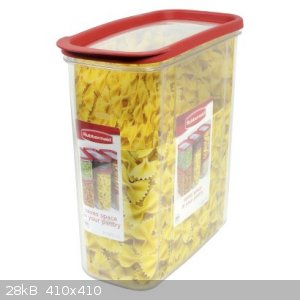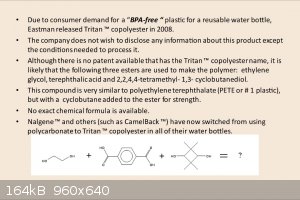UncleJoe1985
Hazard to Self
 
Posts: 88
Registered: 30-9-2008
Location: Sunnyvale, CA
Member Is Offline
Mood: No Mood
|
|
What plastic is this Rubbermaid container made of?

Rubbermaid 21 Cup Premium Food Canister
I want to use it for a chlorate or perchlorate cell, but I don't see any resin code.
It's very transparent (tiny bit less than acrylic). It also has a purple hue when you look at the edges and a barely noticeable purple hue when
looking through it. That makes me think it's polycarbonate. But according to Rubbermaid, they used to use polycarbonate in the premium containers but no longer.
Obviously, this BPA free formulation would be a valuable discovery, but roughly does anyone know what plastic is it most similar too?
There's another container almost exactly like this one but not as transparent. It doesn't have a resin code either but I'm pretty sure it's
polypropylene since it's translucent. Polypropylene seems to be a pretty safe choice since according to the Cole Parmer , it's very resistant against chlorides, chlorates, and hydroxides (D for chlorine water is worrisome)
|
|
|
subsecret
Hazard to Others
  
Posts: 424
Registered: 8-6-2013
Location: NW SC, USA
Member Is Offline
Mood: Human Sadness - Julian Casablancas & the Voidz
|
|
Is there a symbol on the bottom, like a recycling triangle with a number inside? Look up the number and that'll be your plastic.
Fear is what you get when caution wasn't enough.
|
|
|
Dr.Bob
International Hazard
    
Posts: 2661
Registered: 26-1-2011
Location: USA - NC
Member Is Offline
Mood: No Mood
|
|
Some clear containers are made of polymethylpentene, which is water resistant but not so good for organics. But without some sort of confirmation, I
would look it over carefully for a mark on the bottom or something on the label. Polyproylene is usually only translucent but holds up well to most
chemicals.
|
|
|
Zombie
Forum Hillbilly
    
Posts: 1700
Registered: 13-1-2015
Location: Florida PanHandle
Member Is Offline
Mood: I just don't know...
|
|
Here is the rubermaid page for the product you pictured... http://www.rubbermaid.com/Category/Pages/ProductDetail.aspx?...
There is a blue link titled "Need more information"
That link takes you to the contact us page. I would ask them.
They tried to have me "put to sleep" so I came back to return the favor.
Zom.
|
|
|
Bert
Super Administrator
        
Posts: 2821
Registered: 12-3-2004
Member Is Offline
Mood: " I think we are all going to die. I think that love is an illusion. We are flawed, my darling".
|
|
Eastman "Tritan" brand copolyester.
http://en.m.wikipedia.org/wiki/Copolyester
http://www.eastman.com/Literature_Center/M/MBS632.pdf
And Eastman does not care to disclose exactly what this resin may be!
http://ws.eastman.com/ProductCatalogApps/PageControllers/MSD...
| Quote: |
While unpublished studies in 2008 and 2009 by Oregon State students suggest BPA does not leach from polycarbonate plastic under extreme conditions,
BPA is not the only component of plastics which can mimic estrogen and act as an endocrine disruptor.[13] Unfortunately, plastics made of BPA-free
Tritan were later found to leach other estrogenic chemicals in a cell-based assay.[14] Eastman Chemical, the manufacture of Tritan will not disclose
any information about this product or its composition.[15]
|
However, some people are willing to hazard an educated guess...
http://sbi.oregonstate.edu/education/su09interns/Dornath.pdf
[Edited on 29-1-2015 by Bert]

Rapopart’s Rules for critical commentary:
1. Attempt to re-express your target’s position so clearly, vividly and fairly that your target says: “Thanks, I wish I’d thought of putting it
that way.”
2. List any points of agreement (especially if they are not matters of general or widespread agreement).
3. Mention anything you have learned from your target.
4. Only then are you permitted to say so much as a word of rebuttal or criticism.
Anatol Rapoport was a Russian-born American mathematical psychologist (1911-2007).
|
|
|
Etaoin Shrdlu
National Hazard
   
Posts: 724
Registered: 25-12-2013
Location: Wisconsin
Member Is Offline
Mood: Insufferable
|
|
Sure they do. http://www.ncbi.nlm.nih.gov/pubmed/22343188
"Eastman Tritan™ copolyester, a novel plastic from Eastman is manufactured utilizing three monomers, di-methylterephthalate (DMT),
1,4-cyclohexanedimethanol (CHDM), and 2,2,4,4-tetramethyl-1,3-cyclobutanediol (TMCD) in various ratios."
|
|
|
UncleJoe1985
Hazard to Self
 
Posts: 88
Registered: 30-9-2008
Location: Sunnyvale, CA
Member Is Offline
Mood: No Mood
|
|
| Quote: | | [It's] Eastman "Tritan" brand copolyester. |
Very educated guess indeed. There doesn't seem to be a lot of common transparent plastics (Acrylic (polymethlamethacrylate), Butyrate (cellulose
acetate butyrate), Lexan (polycarbonate), and PETG). Acrylic doesn't seem likely since the container isn't as crystal clear. Polycarbonate also seems
to be ruled out since by definition it's made with BPA, contrary to the label, unless Rubbermaid found a way to guarantee there's no unreacted BPA.
Personally, I didn't hear much about the BPA leaching controversy until today nor get why people are making such a fuss. So that leaves Butyrate and
PETG which Tritan is similar too. Plus the container is made in America, so naturally Eastman would be a supplier.
I'll see how well it holds up. According to this table, PET seems pretty bad against NaOH. But according to the attached chart, the NaOH concentration shouldn't go beyond 0.1% by weight
assuming the pH doesn't go above 12.5.
| Quote: | | Some clear containers are made of polymethylpentene |
A high melting point (235C) and chemical resistance make it sound expensive. I wouldn't mind that for just 1 container.
I just had a great idea. Is there a way I can order some polymethylpentene pellets or wire and feed it into a 3D printer to make my own chemically
inert and transparent container? Do all plastics become transparent when melted like? It would be awesome if Teflon can be made transparent.
Attachment: 0901b803800483fc.pdf (29kB)
This file has been downloaded 539 times
[Edited on 29-1-2015 by UncleJoe1985]
|
|
|